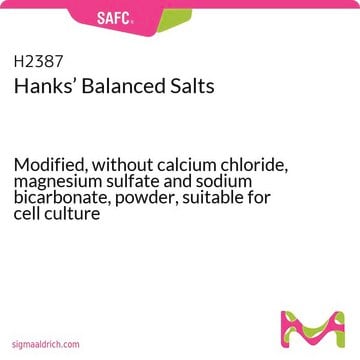H9394
Solução salina balanceada de Hank
Modified, with sodium bicarbonate, without calcium chloride and magnesium sulfate, liquid, sterile-filtered, suitable for cell culture
Sinônimo(s):
HBSS
About This Item
Produtos recomendados
esterilidade
sterile-filtered
forma
liquid
técnica(s)
cell culture | mammalian: suitable
Impurezas
endotoxin, tested
componentes
NaHCO3: 0.35 g/L
glucose: 1.0 g/L (Dextro)
phenol red: 0.011 g/L
Condições de expedição
ambient
Procurando produtos similares? Visita Guia de comparação de produtos
Categorias relacionadas
Descrição geral
Aplicação
- as a component of the culture medium for culturing of mouse cortical slices
- as a component of the dissociation buffer for incubation of human-induced pluripotent stem cells (hiPSCs) and hiPSC-derived cardiomyocytes (CMs)
- for in situ perfusions of mice liver
Ações bioquímicas/fisiológicas
Código de classe de armazenamento
12 - Non Combustible Liquids
Classe de risco de água (WGK)
WGK 1
Ponto de fulgor (°F)
Not applicable
Ponto de fulgor (°C)
Not applicable
Certificados de análise (COA)
Busque Certificados de análise (COA) digitando o Número do Lote do produto. Os números de lote e remessa podem ser encontrados no rótulo de um produto após a palavra “Lot” ou “Batch”.
Já possui este produto?
Encontre a documentação dos produtos que você adquiriu recentemente na biblioteca de documentos.
Os clientes também visualizaram
Protocolos
StableCell™ Trypsin solutions are designed to perform cell detachment as standard trypsin solutions do, without the need to aliquot, freeze, and thaw. This saves significant time before passaging.
Trypsin is commonly used for dissociating adherent cells from surfaces. A wide variety of trypsin solutions are available to meet your specific cell line requirements.
Nossa equipe de cientistas tem experiência em todas as áreas de pesquisa, incluindo Life Sciences, ciência de materiais, síntese química, cromatografia, química analítica e muitas outras.
Entre em contato com a assistência técnica






